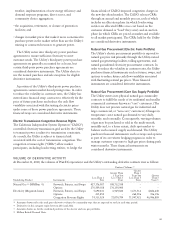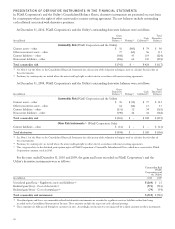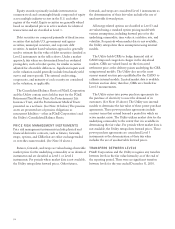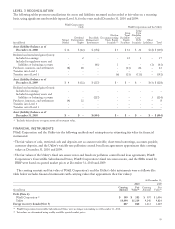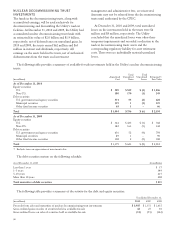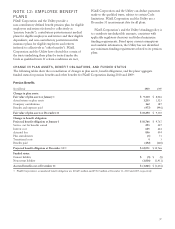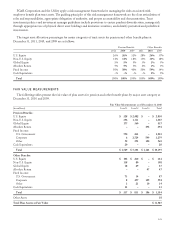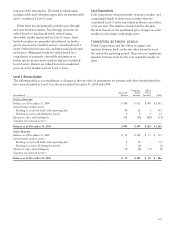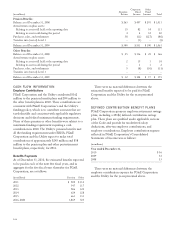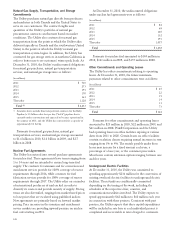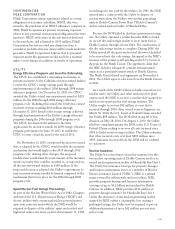PG&E 2010 Annual Report Download - page 103
Download and view the complete annual report
Please find page 103 of the 2010 PG&E annual report below. You can navigate through the pages in the report by either clicking on the pages listed below, or by using the keyword search tool below to find specific information within the annual report.
OtherBenefits
December 31,
(in millions) 2010 2009 2008
Service cost for benefits earned $36 $30 $29
Interest cost 88 87 81
Expected return on plan assets (74) (68) (93)
Amortization of transition obligation 26 26 26
Amortization of prior service cost 25 16 16
Amortization of unrecognized loss (gain) 33 (15)
Net periodic benefit cost $ 104 $94 $44
There was no material difference between PG&E
Corporation and the Utility for the information disclosed
above.
COMPONENTS OF ACCUMULATED OTHER
COMPREHENSIVE INCOME (LOSS)
PG&E Corporation and the Utility record the net periodic
benefit cost for pension benefits and other benefits as a
component of accumulated other comprehensive income
(loss), net of tax. Net periodic benefit cost is composed of
unrecognized prior service costs, unrecognized gains and
losses, and unrecognized net transition obligations as
components of accumulated other comprehensive income,
net of tax. (See Note 2 above.)
Regulatory adjustments are recorded in the
Consolidated Statements of Income and Consolidated
Balance Sheets to reflect the difference between pension
expense or income for accounting purposes and pension
expense or income for ratemaking, which is based on a
funding approach. A regulatory adjustment is also recorded
for the amounts that would otherwise be charged to
accumulated other comprehensive income for the pension
benefits related to the Utility’s defined benefit pension
plan. The Utility would record a regulatory liability for a
portion of the credit balance in accumulated other
comprehensive income, should the other benefits be in an
overfunded position. However, this recovery mechanism
does not allow the Utility to record a regulatory asset for an
underfunded position related to other benefits. Therefore,
the charge remains in accumulated other comprehensive
income (loss) for other benefits.
The estimated amounts that will be amortized into net
periodic benefit cost for PG&E Corporation in 2011 are as
follows:
PensionBenefits
(in millions)
Unrecognized prior service cost $ 35
Unrecognized net loss 48
Total $83
OtherBenefits
(in millions)
Unrecognized prior service cost $ 26
Unrecognized net loss 4
Unrecognized net transition obligation 26
Total $56
There were no material differences between the
estimated amounts that will be amortized into net period
benefit costs for PG&E Corporation and the Utility.
MEDICARE PRESCRIPTION DRUG,
IMPROVEMENT, AND MODERNIZATION ACT OF
2003
The Medicare Prescription Drug, Improvement, and
Modernization Act of 2003 establishes a prescription drug
benefit under Medicare (“Medicare Part D”) and a
tax-exempt federal subsidy to sponsors of retiree health care
benefit plans that provide a benefit that actuarially is at
least equivalent to Medicare Part D. PG&E Corporation
and the Utility determined that benefits provided to certain
participants actuarially will be at least equivalent to
Medicare Part D. Therefore, PG&E Corporation and the
Utility are entitled to a tax-exempt subsidy that reduced the
accumulated postretirement benefit obligation under the
defined benefit medical plan at December 31, 2010 and
2009 and reduced the net periodic cost for 2010 and 2009
by the following amounts:
(in millions) 2010 2009
Accumulated postretirement benefit obligation
reduction $ 72 $ 71
Net periodic benefit cost reduction 1 7
On March 30, 2010, federal health care legislation was
signed eliminating the deduction for subsidy contributions
after 2012. (See Note 9 above.)
There was no material difference between PG&E
Corporation’s and the Utility’s Medicare Part D subsidy
during 2010.
99


